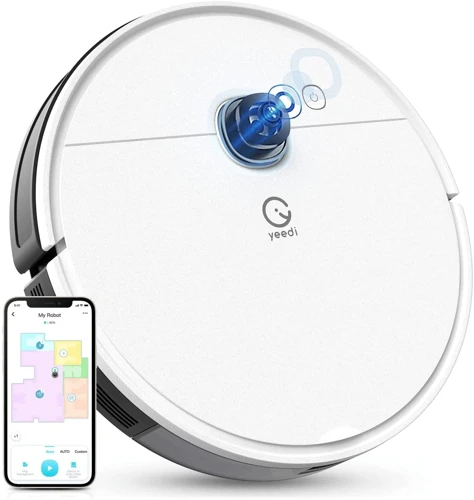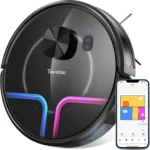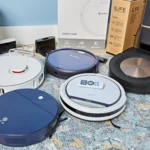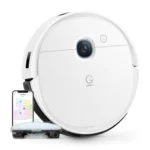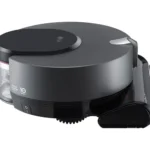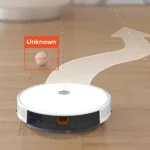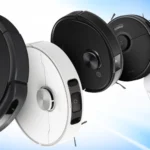Have you ever experienced frustration when your smart vacuum cleaner keeps getting stuck in the same place over and over again? It can be quite perplexing to see an advanced piece of technology like a smart vacuum cleaner struggling to clean effectively and efficiently. However, there is hope for these machines, thanks to the wonders of Smart Mapping technology. With features like object identification, cleaning path optimization, and the inclusion of no-go zones and virtual walls, Smart Mapping has the potential to help prevent smart vacuum cleaners from getting stuck. In this article, we’ll take a closer look at the role of Smart Mapping in helping your vacuum cleaner navigate your home with ease and effectiveness.
What is Smart Mapping?
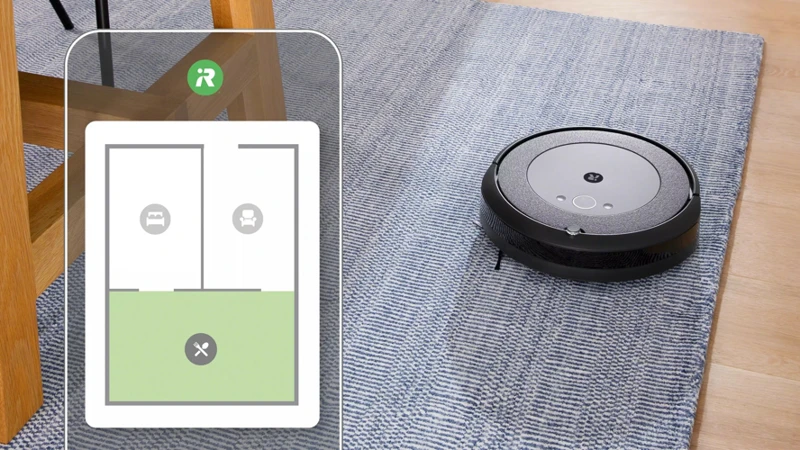
Smart mapping is a revolutionary technology that has drastically improved the efficiency of household cleaning. This technology integrates with smart vacuum cleaners to provide them with a virtual layout of your home. Through this, they can detect obstacles, identify objects, and navigate around your home with ease. Smart mapping offers a range of features that help prevent smart vacuum cleaners from getting stuck. In this section, we’ll delve deeper into what smart mapping is all about, how it works and how it plays a vital role in preventing smart vacuum cleaners from getting stuck. If you’re struggling with a smart vacuum cleaner that keeps getting stuck or is looking to invest in one, then you should read on. You can also check out our other useful guides on smart vacuum cleaner troubleshooting, top 5 reasons why smart vacuum cleaners get stuck and Smart vacuum cleaners getting stuck – Causes and solutions.
The Working of Smart Mapping Technology
Smart mapping technology has revolutionized the way robotic vacuums work. Unlike earlier versions, Smart Mapping Technology enables vacuums to clean homes quickly and more efficiently, ensuring that no spots are left out. But how does this technology work? Here is a step-by-step guide:
- The vacuum uses lasers or cameras to scan the home and create a floor plan in real-time.
- Using the floor plan, the vacuum creates a route map for cleaning the entire area.
- The route map is created by calculating the distance between different points, identifying the position of furniture, walls, and other objects that may impede movement.
- Sensors in the vacuum detect and identify any obstacles, and the system saves that as part of its map to avoid it next time.
- The vacuum uses advanced algorithms to calculate the best cleaning path while avoiding obstacles according to the map.
- Some models also use sim-radar sensors to create a virtual map of its surroundings, which can further optimize the cleaning route.
- If the cleaning path is interrupted, the vacuum saves the last position and route in its memory and resumes cleaning from that point after the obstacle is removed.
All these built-in capabilities ensure that even in complex environments, the vacuum seamlessly moves to every part of the home to provide a complete clean without getting stuck.
However, it is essential to note that Smart Mapping technology is not perfect and may face a few challenges. To learn more about the Top 5 Reasons why Smart Vacuums get stuck click here
The Accuracy of Smart Mapping Technology
We cannot mention smart mapping technology without discussing its accuracy. One of the primary benefits of using smart mapping technology is that it ensures a high level of accuracy in mapping out the cleaning route. The accuracy of smart mapping plays a crucial role in preventing smart vacuums from getting stuck.
To understand the precision of smart mapping technology, we need to take a closer look at its features. Smart mapping technology uses a combination of sensors, cameras, and advanced algorithms to create an accurate map of your home. The map is so precise that it can identify different objects, furniture, and obstacles in your home.
Let’s take a closer look at the accuracy of smart mapping technology in the following table:
| Feature | Details |
|---|---|
| Sensor Technology | Smart mapping technology uses a range of sensors to create a detailed map of your home, including lasers, infrared sensors, bump sensors, and cameras. |
| Mapping Algorithm | The algorithm used by smart mapping technology is highly advanced and can process data quickly to create an accurate and efficient cleaning path. |
| Object Detection | The map created by smart mapping technology can detect and identify different objects, furniture, and obstacles in your home. This ensures that the vacuum does not collide with them. |
| Navigation Precision | The navigation precision of smart mapping technology is incredibly high, enabling the vacuum to follow an accurate cleaning path and avoid getting stuck. |
As you can see, smart mapping technology is highly accurate and reliable. Its ability to detect and identify objects and navigate through space with precision is what makes it an essential tool for preventing smart vacuums from getting stuck.
How Smart Mapping Helps Prevent Smart Vacuum from Getting Stuck
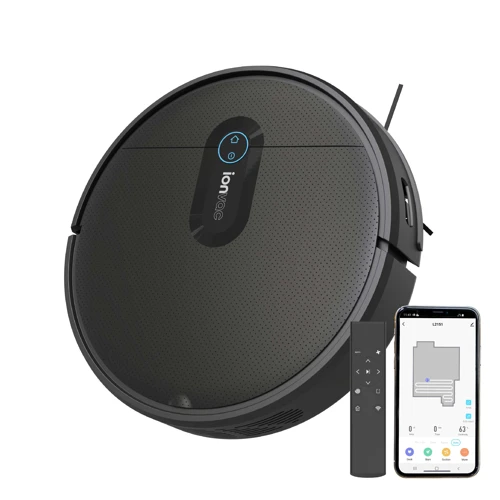
Navigating around objects and obstacles is a major challenge for smart vacuums, but this is where smart mapping comes in. Without smart mapping, vacuums would be much more likely to get stuck or miss sections of your home altogether. By providing an accurate blueprint of your living space and optimizing cleaning paths, smart mapping technology ensures that your smart vacuum can clean your floors with ease. Let’s explore how this technology works and why it’s so crucial to preventing smart vacuums from getting stuck.
Identification of Objects and Obstacles
Smart mapping technology allows smart vacuums to accurately identify and avoid obstacles in their path. This is crucial in preventing the vacuum from getting stuck or damaging itself or the furniture. Here are some ways smart mapping technology identifies objects and obstacles:
- Laser sensors: Smart vacuums use laser sensors to create a map of the room and identify obstacles like furniture or walls. These sensors emit laser beams that bounce back off objects, allowing the vacuum to calculate distance and create a virtual map.
- Camera: Some smart vacuums use cameras to navigate around your home. With the help of computer vision, the vacuum can recognize objects and avoid them. This is especially useful when it comes to detecting and avoiding small objects like shoes or toys.
- Infrared: Infrared sensors can detect the distance between the vacuum and the object. They can also detect movement thanks to the heat being emitted by living creatures. This helps the vacuum identify and avoid pets or humans.
- Bump sensors: Bump sensors are an older technology that helps vacuums steer clear of obstacles. These sensors are attached to the front of the vacuum and detect when it has bumped into something. They then redirect the vacuum in a different direction to avoid hitting the same obstacle again.
Smart vacuums use a combination of these sensors to create an accurate map and avoid obstacles. This technology helps ensure that the vacuum can clean thoroughly while avoiding damage to itself or your home.
Cleaning Path Optimization
One of the key benefits of smart mapping technology in preventing smart vacuum cleaners from getting stuck is cleaning path optimization. This refers to the ability of the vacuum cleaner to map out the most efficient cleaning path based on the layout of the room, in order to avoid obstacles and complete cleaning tasks faster and more effectively.
How does cleaning path optimization work?
Smart mapping technology uses advanced algorithms to determine the best cleaning path for a given room. The vacuum cleaner’s sensors and cameras are used to create a virtual map of the space, which is then used to plot an optimized cleaning path. This path takes into account the location of obstacles, furniture, and other objects in the room, and calculates the most efficient route for the robot to follow.
To illustrate this concept, consider the following table:
| Room | Obstacles | Optimized Cleaning Path |
|---|---|---|
| Bedroom | Bed, Dresser, Chair | Start at door, clean around bed, under dresser, around chair |
| Kitchen | Island, Table, Chairs | Start along wall, clean around island, under table, around chairs |
| Living Room | Couch, TV Stand, Coffee Table | Start at door, clean around couch, under TV stand, around coffee table |
As you can see, the vacuum cleaner is able to determine the most effective cleaning path based on the layout and objects in each room. This helps to prevent it from getting stuck or running out of battery before completing the cleaning task.
Benefits of cleaning path optimization
The benefits of cleaning path optimization are numerous. By following an optimized cleaning path, the vacuum cleaner is able to:
– Clean more efficiently and effectively
– Avoid obstacles and objects that could cause it to get stuck
– Complete cleaning tasks faster, saving time and energy
– Reduce wear and tear on its brushes, motors and other components
Cleaning path optimization is a critical feature of smart mapping technology that helps to prevent smart vacuum cleaners from getting stuck while cleaning. By using advanced algorithms to calculate the most efficient cleaning path, these devices are able to navigate around obstacles and clean more effectively in less time.
Inclusion of No-Go Zones and Virtual Walls
With smart mapping technology, smart vacuum cleaners can now detect and avoid areas where they are not supposed to clean. This is facilitated by the inclusion of No-Go Zones and Virtual Walls. These features help the cleaner to navigate around sensitive areas in the house with ease, ultimately preventing it from getting stuck.
Here’s a breakdown of how these features work:
- No-Go Zones: This feature allows homeowners to create boundaries within the smart vacuum’s cleaning area that it cannot cross. With the help of sensors and the smart map developed by the cleaner, homeowners can easily identify areas within the house where the cleaner should not clean. These could be areas with fragile items or places with high foot traffic that could disrupt the cleaning process. By setting up the No-Go Zones through a connected app, the smart vacuum can avoid cleaning these areas, making its cleaning process more efficient.
- Virtual Walls: This feature is similar to No-Go Zones but offers more flexibility. With virtual walls, homeowners can create boundaries that the smart vacuum cleaner should not cross. Unlike No-Go Zones, which require actual physical barriers, virtual walls make use of infrared signals or magnetic strips to create an invisible barrier that tells the cleaner to avoid that particular area. This feature is especially useful for larger spaces, where physical barriers may not be practical.
Although these features are crucial in preventing smart vacuums from getting stuck, the cleaning process is not overly disrupted. The features are designed to ensure that the cleaning process is still efficient and thorough. Homeowners can easily customize the settings through the accompanying app, which enables them to set up and adjust the No-Go Zones and virtual walls.
Including No-Go Zones and Virtual Walls in smart vacuum cleaners is a significant step in preventing them from getting stuck. These features allow the cleaner to navigate around the house with ease and avoid areas that could potentially disrupt the cleaning process. With the added benefit of customization, homeowners can easily tweak and adjust the settings to ensure optimal cleaning efficiency.
Ability to Resume Cleaning After Interruption
One of the amazing benefits of smart mapping technology for smart vacuums is the ability to resume cleaning after any interruptions. Interruptions may arise during a cleaning process especially when the vacuum needs to be charged or when the dustbin becomes full. With the ability to resume cleaning after an interruption, the smart vacuum not only saves time and effort but also ensures the home is spotlessly clean at all times.
How does the Resuming Cleaning Process Work?
When a smart vacuum cleaner encounters an interruption, it pauses the cleaning process and returns to its charging dock. Once it has fully charged and the dustbin has been emptied, it is able to resume cleaning exactly from where it left off. This is an incredibly useful feature since it eliminates the need to manually restart cleaning or to constantly monitor the vacuum to see when it stops. The smart mapping technology allows for the vacuum to continue cleaning in a logical pattern that eliminates duplicate work and ensures that every spot is thoroughly covered.
Benefits of the Resumable Cleaning Feature
The ability to resume cleaning after an interruption provides several benefits that make it worth the investment. For instance, it ensures that the home is always clean since the vacuum will be able to complete the cleaning process even when interrupted. It helps to save time and effort since the smart vacuum will handle the task by itself, and the user does not have to keep an eye on it when it is cleaning. This means that the user can attend to other tasks or even leave the house without having to worry about the vacuum not completing the cleaning job.
Factors that Affect Resumable Cleaning
While the resumable cleaning feature offers great benefits, it is affected by certain factors that may hinder its effectiveness. These factors include the battery life of the vacuum and the capacity of the dustbin. If the battery life of the vacuum is relatively short, it may not be able to complete the cleaning process even after a full charge. Similarly, if the dustbin capacity is low, the vacuum may have to return to the charging dock regularly for dustbin emptying.
The resumable cleaning feature made possible by smart mapping technology is an incredibly useful feature that makes cleaning effortless and efficient. It ensures the home is always clean by allowing the vacuum to complete the cleaning job even when interrupted. As with any other technological advancement, there are certain factors that can affect the effectiveness of this feature. Nonetheless, the benefits provided by this feature make it worth the investment.
| Advantages | Disadvantages |
|---|---|
| – Continues cleaning process until completed – Saves time and effort – Eliminates the need to manually restart cleaning – Able to clean in a logical pattern |
– Affected by battery life – Affected by dustbin capacity |
Other Factors That Help Smart Vacuum from Getting Stuck
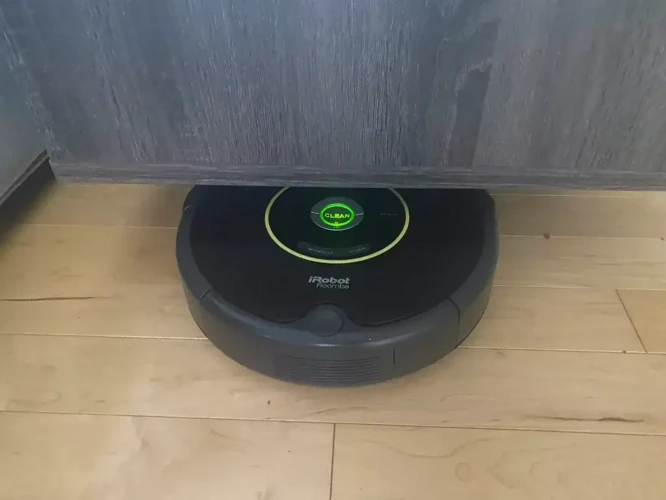
When it comes to smart vacuums, preventing them from getting stuck is a crucial factor for ensuring efficient cleaning operations. Smart mapping technology plays a significant role in this, but there are other factors to consider. These additional aspects contribute to keeping your smart vacuum running smoothly and reducing the likelihood of it getting stuck during cleaning. In this section, we’ll dive deeper into these factors and explore how they impact the overall performance of your smart vacuum.
Sensor Technology
The role of sensor technology cannot be overlooked in preventing smart vacuum cleaners from getting stuck. Sensors are responsible for detecting obstacles and mapping out the room. They allow the vacuum cleaner to distinguish between furniture and floor space, ensuring that it only cleans the latter. In order to understand the effectiveness of sensor technology, let’s consider some of the key sensors that smart vacuum cleaners use:
| Sensor | Description |
|---|---|
| Cliff sensors | These sensors use infrared technology to detect drops, such as stairs or ledges, and prevent the vacuum cleaner from falling off them. |
| Bumper sensors | When the vacuum cleaner detects an obstacle, the bumper sensors will signal the device to slow down and gently tap the object before reversing and changing direction. This prevents the vacuum cleaner from crashing into furniture and causing damage to both the vacuum cleaner and the furniture. |
| Optical sensors | These sensors are used to detect the presence of large objects, such as walls or furniture, which allows the vacuum cleaner to change direction and continue cleaning. |
| Sonar sensors | Sonar sensors emit ultrasonic waves that bounce off of surrounding objects and return to the sensor to determine their distance from the vacuum cleaner. |
| Camera sensors | Camera sensors, which are becoming increasingly common in modern smart vacuum cleaners, provide a more detailed and accurate view of the room. This allows the vacuum cleaner to create more comprehensive maps of the room and avoid all objects and obstacles with greater precision. |
In summary, sensor technology plays a critical role in the effective and efficient operation of smart vacuum cleaners. It helps the device navigate around obstacles and create an accurate map of the room, preventing it from getting stuck and ensuring that it can clean every inch of the floor without causing any damage to furniture or the vacuum cleaner itself.
Power and Suction Capabilities
The power and suction capabilities of a smart vacuum cleaner play a crucial role in its effectiveness and ability to navigate through obstructions. In order to ensure that the smart vacuum cleaner does not get stuck, it is important to pay close attention to its power and suction capabilities.
Power: The power of a smart vacuum cleaner is measured in watts. The higher the wattage, the more powerful the vacuum will be. A higher-powered vacuum will be able to clean more efficiently and effectively, especially in larger spaces.
Suction: Suction is an essential component of a vacuum cleaner as it pulls in dirt and debris from the floor. A smart vacuum cleaner with strong suction power will be able to pick up more dirt and debris, ensuring a cleaner living space.
To further highlight the importance of power and suction capabilities, the following table outlines the wattage and suction power of three popular smart vacuum cleaners:
| Smart Vacuum Cleaner | Wattage | Suction Power |
|---|---|---|
| iRobot Roomba 980 | 33 watts | 1700 Pa |
| Xiaomi Mi Robot Vacuum | 50 watts | 1800 Pa |
| Ecovacs Deebot Ozmo 950 | 40 watts | 2000 Pa |
As seen in the table, the Ecovacs Deebot Ozmo 950 has the highest suction power at 2000 Pa, followed closely by the Xiaomi Mi Robot Vacuum with 1800 Pa. The iRobot Roomba 980 has a slightly lower suction power of 1700 Pa.
It is important to note that while power and suction capabilities are crucial, other factors such as the design of the vacuum’s wheels and brushes, as well as its battery life and charging capabilities, can also play a significant role in preventing a smart vacuum cleaner from getting stuck.
Wheel and Brush Design
The wheel and brush design of a smart vacuum cleaner are crucial factors that determine its effectiveness in cleaning various surfaces without getting stuck. High-quality wheels and brushes can ensure that the device moves smoothly on different floor types and carpets, picking up debris and dirt with ease.
The wheels of a smart vacuum cleaner should have sufficient traction and grip to prevent slippage and skidding. They should also be sized appropriately to facilitate movement on tight corners and narrow spaces. Additionally, the wheels should have a suitable suspension system that allows for smooth transitions over bumps and obstacles.
The brush design is equally vital because it determines the device’s ability to dig into carpets and dislodge dirt and pet hair effectively. Rotating brushes with bristles of varying lengths and stiffness can enhance the vacuum cleaner’s cleaning capability, especially on carpets and area rugs.
The brush should have anti-tangle technology that prevents hair and debris buildup, which can cause the device to get stuck or shut down. Smart vacuums that come with brushes that can be easily removed and cleaned offer added convenience and longevity.
A smart vacuum cleaner’s wheel and brush design are critical in ensuring smooth operation and effective cleaning without getting stuck. When choosing a smart vacuum cleaner, it’s essential to consider these factors to ensure optimal performance and longevity.
Battery Life and Charging
The battery life and charging of a smart vacuum cleaner plays a crucial role in preventing it from getting stuck mid-cleaning. A longer battery life ensures that the vacuum cleaner can cover larger areas without requiring frequent recharging.
Charging Time: One of the key factors to consider is the charging time of the vacuum cleaner. It’s important to choose a vacuum cleaner that has a battery that charges quickly. This will ensure that the vacuum cleaner is ready to clean at all times.
Battery Life: Another important factor to consider is the battery life of the vacuum cleaner. A longer battery life means that the vacuum cleaner can clean for a longer period without requiring frequent recharging. This is especially important if you have a large house with multiple rooms to vacuum.
Battery Indicators: It’s important to choose a vacuum cleaner that has a battery indicator. This will let you know when the battery is running low and needs to be charged. Some vacuum cleaners have LED lights that indicate the battery level, while others have an app that notifies you when the battery is running low.
Automatic Charging: Some smart vacuum cleaners have the ability to automatically return to the charging station when the battery is low. This means that the vacuum cleaner can recharge itself without any intervention from the user. This feature ensures that the vacuum cleaner is always ready to go when you need it.
Portable Charging: Look for a vacuum cleaner that comes with a portable charging dock. This makes it easy to charge the battery without moving the entire vacuum cleaner to the charging station.
The battery life and charging capabilities of a smart vacuum cleaner are important factors to consider when purchasing one. A vacuum cleaner with a long battery life, quick charging time, battery indicators, automatic charging, and portable charging dock can ensure that the vacuum cleaner is always ready to clean and prevent it from getting stuck mid-cleaning.
Challenges That Smart Mapping Technology Faces
As revolutionary as smart mapping technology is, it is not without its challenges. Many factors come into play, such as the compatibility with different floor types, applicable home layouts, and cost vs. quality trade-offs. Overcoming these challenges is essential to provide consumers with the most effective and efficient cleaning experience. Let’s now explore some of the hurdles that smart mapping technology faces and how they impact its performance.
Compatibility with Different Floor Types
One of the challenges that smart mapping technology faces is compatibility with different floor types. While some vacuum cleaners may work perfectly on hardwood floors, they may not perform as well on carpets or rugs. This is because different floor types have different textures and thicknesses, which can affect the cleaning performance of the vacuum.
To overcome this challenge of compatibility, manufacturers of smart vacuums have designed their products to be versatile and capable of cleaning different floor types. Some smart vacuums have automatically adjusting brush rolls that can adapt to the different thicknesses of the carpet or rug. Other vacuums have multi-surface brushes that are designed to clean both floors and carpets.
Additionally, some smart vacuums have suction power control features that adjust the suction power based on the surface being cleaned. For instance, a higher suction power may be needed for cleaning carpets as compared to cleaning hardwood floors.
Apart from the suction and brush features, smart vacuums also come with different wheel designs that can handle different flooring materials. For instance, some vacuums have larger wheels for better mobility on rugs or carpets, while others have smaller wheels that are ideal for hardwood floors.
Smart mapping technology is constantly evolving to meet the compatibility needs of different floor types. Smart vacuum manufacturers are utilizing different features like adjustable brushes, multi-surface brushes, suction power control, and different wheel designs to ensure their vacuums can handle various flooring materials effectively.
Applicable Home Layouts
When it comes to the application of smart mapping technology, it’s important to consider applicable home layouts. Not all homes are built the same, and some layouts may pose a challenge to the optimal functioning of a smart vacuum cleaner.
Below is a table outlining the various home layouts and their compatibility with smart mapping technology.
| Home Layout | Smart Mapping Compatibility | Explanation |
|---|---|---|
| Open Floor Plan | Highly Compatible | This layout allows for easy navigation and cleaning efficiency as there are no strict boundaries for the vacuum cleaner to adhere to. |
| Multi-Level | Compatible with Limitations | While a smart vacuum cleaner can work with multiple levels, it may face difficulty climbing stairs or transitioning between levels without intervention. |
| Cluttered | Low Compatibility | A cluttered home with various obstacles and objects may pose a challenge for the smart vacuum cleaner to navigate, leading to repeated suction attempts and even getting stuck. |
| Small Spaces | Highly Compatible | With smart mapping technology, even small spaces can be efficiently cleaned and navigated, as the technology allows for optimized cleaning paths and obstacle avoidance. |
| Large Spaces | Compatible with Limitations | A smart vacuum cleaner can still navigate large spaces, but may require increased charging time and more meticulous programming. |
It’s important to note that while smart mapping technology has greatly improved the capabilities of smart vacuum cleaners, the layout of a home can still pose a challenge. However, with advances in technology and continued research, we can expect even greater compatibility in the future.
Cost vs. Quality
One of the biggest considerations when it comes to purchasing a smart vacuum cleaner is the cost versus quality ratio. There are several factors that come into play when determining the best vacuum for your budget and needs. Here are a few points to consider:
- Brand reputation: A well-established brand with a good reputation in the industry is generally a safer bet when it comes to quality. However, these models may come with a higher price tag.
- Features: The more advanced the features, the higher the cost. Decide on what features you need versus what features you want.
- Battery life: Longer battery life means more cleaning power, but it also usually increases the cost.
- Warranty: Look for a warranty that covers a decent amount of time, especially for the more expensive models. This can give you peace of mind and protect your investment.
- Reviews: Always be sure to read reviews from other users before buying. This can give you an idea of the quality and reliability of certain models.
- Long-term cost: While a cheaper model may seem appealing at first, consider the long-term cost of constantly replacing parts or buying a new vacuum altogether. A higher quality vacuum may pay off in the long run.
It’s important to find the right balance between cost and quality. Look for a model that has the features you need while being reasonably priced and reliable. Keep in mind that the most expensive model may not necessarily be the best fit for your needs.
Conclusion
In conclusion, it is evident that smart mapping technology plays a crucial role in preventing smart vacuum cleaners from getting stuck. The technology not only identifies and avoids obstacles, but also optimizes cleaning paths, includes no-go zones and virtual walls, and has the ability to resume cleaning after interruption. These features provide a seamless cleaning experience for users and alleviate the frustration of having to dislodge the vacuum cleaner from tight spaces or corners.
However, it is important to note that smart mapping technology is not foolproof and faces challenges such as compatibility with different floor types, applicable home layouts, and cost versus quality. These challenges need to be addressed for the technology to be fully effective and accessible to all users.
Nonetheless, the integration of smart mapping technology with other features such as sensor technology, power and suction capabilities, wheel and brush design, and battery life and charging, further enhance the performance of smart vacuum cleaners and prevent them from getting stuck.
Overall, smart mapping technology is a significant development in the world of smart vacuum cleaners and has revolutionized the way we clean our homes. As technology continues to advance, we can expect even more sophisticated and efficient features to be added, making the cleaning process even easier and more seamless for users.
Frequently Asked Questions
How does Smart Mapping work?
Smart mapping uses sensors and cameras to create a virtual map of your home. It then uses this map to navigate your floors and clean them efficiently.
Will a Smart Vacuum cleaner work on all floor types?
Smart vacuum cleaners work on most floor types, including hardwood, tile, and carpet. However, they may not work on certain types of rugs or high-pile carpets.
Can Smart Mapping technology recognize different types of objects?
Yes, Smart Mapping can recognize different types of objects, including furniture, walls, and other obstacles in your home.
Are Smart Vacuum cleaners able to clean multiple levels of a home?
Some Smart Vacuum cleaners are able to clean multiple levels of a home. Check with the manufacturer to see if the vacuum cleaner you are interested in has this capability.
Can Smart Vacuum cleaners avoid stairs?
Yes, Smart Vacuum cleaners have sensors that allow them to detect stairs and avoid falling down them.
How do Smart Vacuum cleaners deal with pet hair?
Smart Vacuum cleaners with strong suction and special brushes are able to effectively pick up pet hair and debris. Look for a vacuum cleaner with a high suction power if you have pets.
Are Smart Vacuum cleaners able to detect and clean corners?
Yes, Smart Vacuum cleaners are able to detect and clean corners and other hard-to-reach areas in your home.
Is it necessary to have Wi-Fi for a Smart Vacuum cleaner to work?
No, Wi-Fi is not necessary for a Smart Vacuum cleaner to work. However, it may be necessary for certain features like app control and voice assistant integration.
How long does it take for a Smart Vacuum cleaner to fully charge?
It usually takes between 1-3 hours for a Smart Vacuum cleaner to fully charge, depending on the model.
Is Smart Mapping technology expensive?
Smart Mapping technology can be expensive, but there are affordable options available. Consider your budget and research different options before making a purchase.
